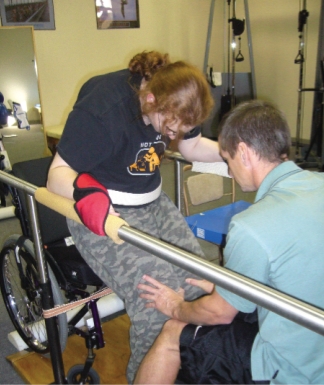Exercise for People With Paralysis
Daniel Ball, MSc, and trainers at Pushing Boundaries help clients recapture lost physical function.

Some of the clients at Pushing Boundaries travel more than 3 hours a day several times a week to train at the company’s site in Redmond, Washington. Then they spend 2 hours training. Why are they so committed to exercise? Because for them, working out doesn’t just mean losing weight or running faster. It means reclaiming independence and abilities, such as being able to walk.
Pushing Boundaries is an intensive exercise facility that provides people with paralysis concentrated and repetitious exercise to reconnect neural pathways and regain function after illness or injury, explains IDEA Master Personal Trainer Daniel Ball. Personal trainers work one-on-one with clients. Ball’s primary responsibility is research and program development, but he also trains clients and helps with fundraising and community relations.
Ball comes from a family used to tackling challenges. “My father became an amputee after losing his right leg in World War II. He has spent 40 years making prosthetic devices for fellow amputees,” says Ball. “Of my three brothers, one is developmentally disabled, another is an adaptive physical-education instructor and the third is a speech pathologist. So I guess helping people with challenges runs in the family! At home I learned that people will accomplish incredible things when given the opportunity. I’m excited to help our clients have this opportunity as well.”
Recreating Lost
Neural Pathways
How do personal trainers help these clients who suffer from diminished neural activity? “Many of the exercises are similar to those performed with an able-bodied client,” says Ball. “However, the exercise therapist will often generate and guide the movement manually for the clients with high repetition until they are able to perform the movement themselves. Clients participate in intensive 2-hour workouts, with the focus on recreating lost neural pathways. Repetition is the key. Depending on the level of injury and the existing preserved neural connections a client has, a trainer designs an individualized workout to build on his or her strengths. A session includes cardio, strength training and flexibility, with visualization and audio cues being a huge part of the workout.”
About 70% of the clients use some sort of cardio machine, says Ball. “One type is called a functional electrical stimulation (FES) recumbent cycle. Electrode pads deliver a synchronized stimulus to the leg muscle (electric shock that contracts the muscle) in the actual sequence of cycling. The device acknowledges the client’s level of participation and effort and compensates with electrical stimulus. For example, if someone can provide 20% of the power needed to cycle, the bike will provide 80%.”
Improving Clients’ Lives
“No one knows just how much movement a person will get back after an injury, because every injury is different,” says Ball. “But if there is a way to relearn, strengthen and improve, we will find it. We see clients break through barriers every day, whether [that is] becoming strong enough to drive, resume work, live independently or, for some, walk again.”
Ball finds his work extremely rewarding. “I’ve seen time and time again clients who arrive mad at the world, daring someone to help them,” he says. “A few short weeks later I find them joking with their trainers and encouraging their fellow trainees. The bonds developed between clients and trainers and between the clients themselves are special and enduring.”
A client named Arby describes his
experience at the facility: “When I left the hospital I felt lost, depressed and hope-
less. The first time I went to Pushing Boundaries I sat on a mat with my trainer and could barely balance myself because I was so weak and so used to spending all my time in my wheelchair. After 2 years, I have overcome many obstacles: learning to balance, roll over, crawl, stand and now take steps with a walker. I still use my wheelchair for my main mode of transportation, but with intense gait training I hope to graduate to walking on my own in no time.”
Ball has been a personal trainer and a health educator for 25 years. “The goals of our clients are quite different from the goals of the clients I trained previously,” he says. “The clients here are literally fighting to resume as much of their preparalysis life as possible. Rarely do fitness professionals work with an entire group of people who are as intensely motivated as those who are suddenly paralyzed. It is amazing to see firsthand when clients’ efforts are realized.”
Ball encourages other personal trainers to look into working with this type of client. “What we are doing is truly groundbreaking. Every year more facilities like ours are opening up across the country, and personal trainers are a big part of their staff.”
For more information about the type of training done at Pushing Boundaries, see www.pushing-boundaries.org.
IDEA’s campaign unites our members with those of other organizations in a joint effort to reach out to nonexercisers. Our commitment is to provide you with information and sources so you can act locally.
Are your clients obese, disabled or just starting to exercise after years of sedentary living? We want to hear how you are motivating, challenging and retaining clients on a long-term basis. In 200 words or less, detail the specifics of your program and client(s), along with your name and contact information. If your success story is compelling and unique, we may use it in a future issue or on the Inspire the World to Fitness® section of the website.
E-mail: inspire@ideafit.com
Mail: Sandy Todd Webster
10455 Pacific Center Court
San Diego, CA 92121-4339
Fax: (858) 535-8234






